The mouse TNF-α kit market is forecast to grow from USD 135 million in 2025 to USD 241.8 million by 2035, reflecting a CAGR of 6%. This growth is primarily driven by the increasing demand for mouse TNF-α kits in biotechnology, pharmaceutical research, and medical diagnostics. These kits, used to detect and quantify tumor necrosis factor-alpha (TNF-α) in mice, are critical tools for understanding immune responses, inflammation, and various disease mechanisms. As preclinical research and drug development continue to advance, the need for accurate and reliable TNF-α measurement will support market growth.
The expanding focus on immunology research and inflammatory diseases such as autoimmune disorders and cancer will also fuel the demand for these kits. Moreover, technological advancements in biomarker detection and high-throughput screening are likely to enhance the performance and capabilities of mouse TNF-α kits, making them even more essential for research and clinical applications. As the healthcare and pharmaceutical industries continue to innovate, the market for Mouse TNF-α kits will experience consistent growth, supported by the expanding need for more precise and efficient research tools.
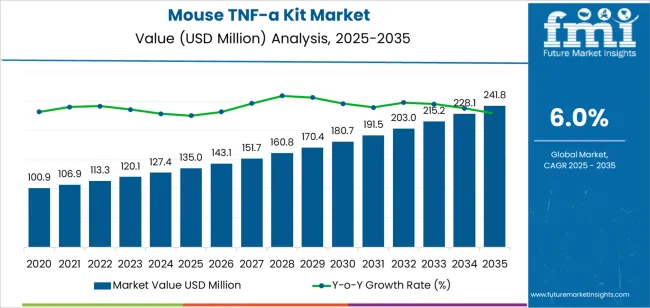
From 2025 to 2030, the market is expected to grow from USD 135 million to USD 180.7 million, adding USD 45.7 million. This phase will see growing demand in biomedical research, driven by increasing studies on inflammatory diseases, immunology, and oncology. The use of mouse TNF-α kits in drug development and preclinical testing will continue to be key drivers of market expansion.
Between 2030 and 2035, the market is forecast to expand from USD 180.7 million to USD 241.8 million, adding USD 61.1 million in value. This period will see further growth driven by continued innovations in immunotherapy, biomarker identification, and the rising prevalence of chronic diseases requiring detailed immune response profiling. The increasing emphasis on personalized medicine and advanced diagnostic technologies will contribute significantly to the market’s sustained growth through 2035.
| Metric | Value |
|---|---|
| Market Value (2025) | USD 135 million |
| Market Forecast Value (2035) | USD 241.8 million |
| Forecast CAGR (2025-2035) | 6% |
The mouse TNF-α kit market is experiencing steady growth, driven by the rising demand for high-quality research tools in biomedical and pharmaceutical research. Tumor Necrosis Factor-alpha (TNF-α) is a key cytokine involved in inflammation and immune system regulation, making it an important target in immunology and disease studies. The increasing focus on immunotherapy, cancer research, and chronic inflammatory diseases is spurring the demand for reliable testing kits. Moreover, the rise in biotechnology innovations and the growing number of research centers and universities involved in TNF-α-related research are further boosting market growth. Government funding for scientific research and development in immunology is also contributing to market expansion, particularly in regions like China and India.
The increasing prevalence of autoimmune diseases, infectious diseases, and cancer is further propelling the need for precise diagnostic tools and testing solutions. Research facilities and academic institutions are increasingly using TNF-α kits for understanding the role of TNF-α in disease progression and developing new therapeutic interventions. With innovations in biotechnology and the continuous need for new and improved diagnostic tests, the mouse TNF-α kit market is expected to grow steadily in the coming years.
The mouse TNF-α kit market is structured around segments by purity and by application, reflecting the diverse needs of research and academic institutions globally. By purity, the market distinguishes kits with purity ≥95% and those with purity <95%, with the high purity segment dominating due to its use in advanced immunology and therapeutic research. By application, the market separates demand from research centers and from universities, with research centers leading due to heavier funding and higher throughput requirements. Regions such as Asia Pacific (China, India) and Europe (Germany) show strong growth, driven by increasing biotechnology investment and regulatory focus on precision research.
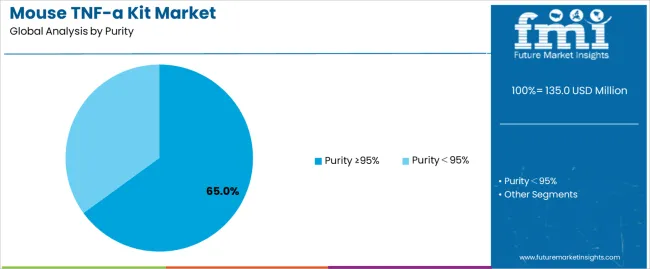
The purity ≥95% segment holds a dominant share in the mouse TNF-α kit market, driven by the critical need for high specificity and minimal background interference in advanced research. These high purity kits are preferred by research centers conducting immunology, oncology, and inflammation studies, where measurement accuracy is vital. Such kits are essential when studying subtle variations in TNF-α expression in mouse models of disease, ensuring reproducibility and reliability of data. Research centers often require reagents that meet stringent technical specifications, such as low cross reactivity and high sensitivity, making high purity kits the default choice. Furthermore, pharmaceutical companies and biotech firms engaged in drug discovery use these kits in crucial assays where data integrity can influence development decisions. As global research activity grows-especially in emerging economies like China and India-the preference for high purity kits accelerates, reinforcing their leadership in this segment.
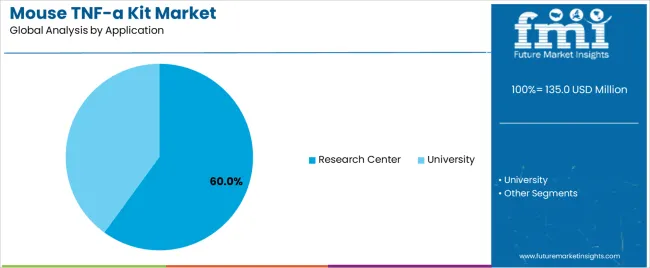
The research center segment leads demand in the mouse TNF-α kit market, accounting for a substantive share. Research centers-both public and private-drive large-scale studies into cytokine biology, inflammatory disease mechanisms, and preclinical testing, necessitating robust kits for TNF-α measurement. These institutions typically have higher budgets, deploy more advanced instrumentation, and run high-throughput workflows, thus favouring premium reagents and kits. The focus on immunotherapy, autoimmune disorders, and infectious disease research amplifies usage of TNF-α kits in these settings. Additionally, research centers in regions such as China and Germany are experiencing increased investment, enabling expansion of lab capacity and adoption of cutting edge kits. While universities contribute substantially and often collaborate with industry, their resource constraints and broader educational remit mean slower adoption of premium formats. Consequently, the research center application remains the cornerstone of market volume and innovation demand in this field.
The mouse TNF-α kit market is growing steadily due to increased investment in biomedical research, especially in the fields of immunology, oncology, and autoimmune diseases. The rising demand for precise and reliable diagnostic tools in research centers and universities, combined with the growing focus on precision medicine and biotechnology advancements, is driving market growth. Additionally, the expanding need for TNF-α kits to support drug development and clinical trials further contributes to the market’s expansion.
What are the key drivers of the mouse TNF-α kit market?
Key drivers of the mouse TNF-α kit market include the rising prevalence of autoimmune diseases, inflammatory disorders, and cancer, all of which increase the demand for accurate diagnostic tools. As the healthcare industry focuses more on immunotherapy and personalized medicine, there is a greater need for TNF-α testing to understand disease mechanisms and develop new treatments. Additionally, government funding and public-private partnerships are supporting biomedical research, further boosting the demand for these specialized testing kits. The increasing adoption of biotechnology innovations in both academic institutions and pharmaceutical companies also fuels market growth.
What are the key restraints in the mouse TNF-α kit market?
Despite steady growth, the mouse TNF-α kit market faces certain restraints. One of the primary challenges is the high cost of high-purity kits, especially those with purity ≥95%, which may limit their adoption in budget-constrained research environments. Moreover, complexity in handling and the need for highly specialized training to use these kits accurately could deter some potential customers. The lack of awareness in emerging markets and regulatory hurdles associated with international distribution and compliance also present barriers to the market’s expansion.
What are the key trends in the mouse TNF-α kit market?
Key trends in the mouse TNF-α kit market include a shift towards automated testing and high-throughput screening, which are increasingly demanded by research centers for large-scale studies. There is also a growing focus on digitalization and data integration in scientific research, which allows for more efficient TNF-α measurement and real-time data analysis. Furthermore, advancements in biotechnology are contributing to the development of more sensitive, specific, and user-friendly testing kits, as well as the integration of IoT-enabled devices for better performance tracking and monitoring in labs and clinical trials.
The mouse TNF-α kit market is witnessing variable growth trajectories across different geographies, driven by factors such as research funding, biotechnology infrastructure, and prevalence of immunological disorders. Emerging markets like China and India are expected to record higher growth rates due to rapid expansion of biomedical research centres and increased public private investment in life sciences sectors. In contrast, mature markets such as the USA, the UK and Japan are characterised by slower yet steady growth, reflecting high market saturation but continued demand for premium research reagents. Understanding each country’s growth rate and scientific ecosystem helps stakeholders tailor strategies for regional penetration and product adoption.
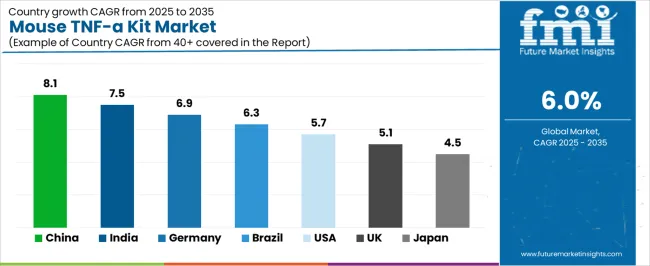
| Country | CAGR (%) |
|---|---|
| China | 8.1% |
| India | 7.5% |
| Germany | 6.9% |
| Brazil | 6.3% |
| USA | 5.7% |
| UK | 5.1% |
| Japan | 4.5% |
China is expected to grow at a CAGR of 8.1% in the mouse TNF-α kit market. The country’s expansion is driven by increasing government funding, rising number of biotech start ups, and major investments in immunology and oncology research. Many Chinese research centres are upgrading lab infrastructure, adopting high purity reagents, and collaborating globally, thus boosting demand for TNF-α kits. Moreover, the strong focus on precision medicine and immunotherapy in China generates significant demand for assays that measure cytokines like TNF-α. The large population base and increasing incidence of chronic inflammatory and autoimmune diseases further support market growth. As China continues to advance its life sciences ecosystem, it represents a top growth opportunity in this market segment.
India is forecast to grow at a CAGR of 7.5% in the mouse TNF-α kit market. With a rapidly developing biotech sector and growing number of academic and research centres, India’s demand for high quality reagents like TNF-α kits is increasing. The government’s “Make in India” initiative and rising healthcare research funding are driving investments in immunology research infrastructure. Additionally, India’s high burden of infectious diseases, autoimmune disorders, and cancer creates greater need for cytokine detection assays in preclinical and translational research. While cost sensitivity remains a challenge, improved awareness, global collaborations and growing contract research organisation (CRO) activity are expected to elevate market penetration.

Germany is projected to grow at a CAGR of 6.9% in the mouse TNF-α kit market. As Europe’s scientific hub, Germany boasts advanced laboratory infrastructure, strong pharmaceutical and biotechnology industries, and robust research funding. Demand for high purity reagents is driven by stringent regulatory standards and the prevalent use of immunology assays in drug discovery and translational research. German universities and research institutes frequently adopt cutting edge science tools, creating sustained demand for TNF-α kits. While growth is more moderate compared with emerging markets, Germany remains a strategic market for premium reagent suppliers due to the quality oriented purchase behaviour and strong life sciences tradition.
Brazil is expected to grow at a CAGR of 6.3% in the mouse TNF-α kit market. Growth in Brazil is powered by expansion of academic research, increasing funding for biomedical studies, and improvements in healthcare research infrastructure. The country’s universities and research institutes are becoming more engaged in immunology and inflammation research, raising the demand for cytokine detection kits. However, budget constraints and fluctuating funding cycles impose some limitations. Despite this, large population size, rising disease burden, and growing collaboration with international biotech companies present significant opportunity for TNF-α kit providers to expand in Latin America.

The USA is projected to grow at a CAGR of 5.7% in the mouse TNF-α kit market. As the global leader in biotech and pharmaceutical research, the USA has a mature market characterised by high quality demand, advanced instrumentation and regulatory complexity. Research centres and universities conduct extensive immunology and oncology work, requiring premium reagents. While incremental growth is slower compared to emerging economies, the US market remains critical due to high per unit pricing, large installed base of research labs and ongoing drug discovery programmes targeting TNF-α pathways. Suppliers with advanced assay performance continue to focus on this market for profitability.
The UK is projected to grow at a CAGR of 5.1% in the mouse TNF-α kit market. With strong academic institutions, leading biotech clusters and government research funding, the UK maintains steady demand for high precision immunology kits. The UK’s focus on translational research, personalised medicine and cytokine biology supports demand for TNF-α assays. Although growth is moderate due to market maturity, the UK remains a key region for pilot studies, drug development and partnerships. Suppliers often target UK institutions to validate reagents and build reputational credibility before broader expansion.

Japan is expected to grow at a CAGR of 4.5% in the mouse TNF-α kit market. As a mature research market with advanced healthcare and biotech industries, growth in Japan is driven by high standards of reagent quality, precision science and a well developed academic ecosystem. The lower growth rate reflects market saturation and strong local reagent manufacturing, but demand remains steady as Japanese research institutes continue to conduct advanced studies into inflammation, immunology and therapeutic development. For reagent suppliers, Japan represents a market where product validation, localisation and high service levels are critical.
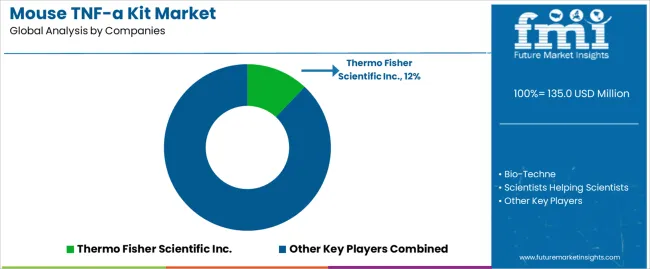
The mouse TNF-α kit market is dominated by a mix of large multinational life science corporations and specialised reagent providers. Companies such as Thermo Fisher Scientific Inc. (holding approximately 12% share), Bio Techne, MilliporeSigma and FUJIFILM Irvine Scientific lead through their global distribution networks, strong R&D capabilities and extensive validation of high purity kits. These firms maintain competitive advantage via regulatory approvals, broad product portfolios and customized solutions for academic institutions, biotechnology firms and pharmaceutical developers. Their established presence in major research hubs across North America, Europe and Asia gives them scale and influence in the market’s evolution.
Alongside these incumbents, smaller and regional players, such as Sino Biological, Yisheng Biotechnology (Shanghai), Abbkine and Dalian Meilun Biotech, are gaining traction by offering cost competitive kits with good regional support and faster turnaround times. They often target niche research segments or emerging markets where academic research funding is expanding. Strategic collaborations, merger and acquisition activity, and product innovation focused on automation, higher throughput and integrated assay platforms are reshaping this landscape. As research in inflammation, immunotherapy and cytokine biology accelerates globally, especially in China and India, market competition will increasingly revolve around value added features, localised support and distribution flexibility.
| Items | Details |
|---|---|
| Quantitative Units | USD Million |
| Regions Covered | China, India, Germany, Brazil, USA, UK, Japan |
| Purity | Purity ≥95%, Purity <95% |
| Application | Research Center (60%), University |
| Key Companies Profiled | Thermo Fisher Scientific Inc., Bio-Techne, Scientists Helping Scientists, MilliporeSigma, FUJIFILM Irvine Scientific, BD Biosciences, Sino Biological, Inc., BPS Bioscience, Inc., Elabscience, Yisheng Biotechnology (Shanghai) Co., Ltd., Abbkine, Beijing Biocreative Technology Co., Ltd., Shanghai Yaji Biotechnology Co., Ltd., Cellverse Co., Ltd., Dalian Meilun Biotech Co., Ltd. |
| Additional Attributes | The market analysis includes dollar sales by purity and application categories. It also covers regional adoption trends across major markets like China, India, Germany, and the USA. The competitive landscape focuses on key manufacturers in the biotechnological and scientific sectors, with an emphasis on advancements in TNF-α detection kits. Trends in the growing demand for research kits in medical research centers and universities are explored, along with developments in TNF-α related studies. |
The global Mouse TNF-α Kit Market is estimated to be valued at USD 135.0 million in 2025.
The market size for the Mouse TNF-α Kit Market is projected to reach USD 241.8 million by 2035.
The Mouse TNF-α Kit Market is expected to grow at a 6.0% CAGR between 2025 and 2035.
The key product types in Mouse TNF-α Kit Market are purity ≥95% and purity<95%.
In terms of application, research center segment to command 60.0% share in the Mouse TNF-α Kit Market in 2025.






Our Research Products

The "Full Research Suite" delivers actionable market intel, deep dives on markets or technologies, so clients act faster, cut risk, and unlock growth.

The Leaderboard benchmarks and ranks top vendors, classifying them as Established Leaders, Leading Challengers, or Disruptors & Challengers.

Locates where complements amplify value and substitutes erode it, forecasting net impact by horizon

We deliver granular, decision-grade intel: market sizing, 5-year forecasts, pricing, adoption, usage, revenue, and operational KPIs—plus competitor tracking, regulation, and value chains—across 60 countries broadly.

Spot the shifts before they hit your P&L. We track inflection points, adoption curves, pricing moves, and ecosystem plays to show where demand is heading, why it is changing, and what to do next across high-growth markets and disruptive tech

Real-time reads of user behavior. We track shifting priorities, perceptions of today’s and next-gen services, and provider experience, then pace how fast tech moves from trial to adoption, blending buyer, consumer, and channel inputs with social signals (#WhySwitch, #UX).

Partner with our analyst team to build a custom report designed around your business priorities. From analysing market trends to assessing competitors or crafting bespoke datasets, we tailor insights to your needs.
Supplier Intelligence
Discovery & Profiling
Capacity & Footprint
Performance & Risk
Compliance & Governance
Commercial Readiness
Who Supplies Whom
Scorecards & Shortlists
Playbooks & Docs
Category Intelligence
Definition & Scope
Demand & Use Cases
Cost Drivers
Market Structure
Supply Chain Map
Trade & Policy
Operating Norms
Deliverables
Buyer Intelligence
Account Basics
Spend & Scope
Procurement Model
Vendor Requirements
Terms & Policies
Entry Strategy
Pain Points & Triggers
Outputs
Pricing Analysis
Benchmarks
Trends
Should-Cost
Indexation
Landed Cost
Commercial Terms
Deliverables
Brand Analysis
Positioning & Value Prop
Share & Presence
Customer Evidence
Go-to-Market
Digital & Reputation
Compliance & Trust
KPIs & Gaps
Outputs
Full Research Suite comprises of:
Market outlook & trends analysis
Interviews & case studies
Strategic recommendations
Vendor profiles & capabilities analysis
5-year forecasts
8 regions and 60+ country-level data splits
Market segment data splits
12 months of continuous data updates
DELIVERED AS:
PDF EXCEL ONLINE
Mouse RNase Inhibitor Market Size and Share Forecast Outlook 2025 to 2035
Mouse Elevated Cross Maze Market Size and Share Forecast Outlook 2025 to 2035
Mouse T Cell Isolation Kit Market Size and Share Forecast Outlook 2025 to 2035
Rat and Mouse Forced Swimming Test System Market Size and Share Forecast Outlook 2025 to 2035
Wireless Mouse Market
Humanized Mouse Model Market Size and Share Forecast Outlook 2025 to 2035
FTNF Flavor Market Analysis By Type, Application, And Region - Growth, Trends, And Forecast From 2025 to 2035
Kitchen/ Toilet Roll Converting Machines Market Size and Share Forecast Outlook 2025 to 2035
Kitting Robots Market Size and Share Forecast Outlook 2025 to 2035
Kitchen Tools and Accessories Market Size and Share Forecast Outlook 2025 to 2035
Kitchen Trailers Market Analysis - Size, Share, and Forecast Outlook 2025 to 2035
Kitchen Hood System Market Size and Share Forecast Outlook 2025 to 2035
Kitchen Hand Tools Market Size and Share Forecast Outlook 2025 to 2035
Kitchen Hood Market Insights – Trends & Growth Forecast 2025 to 2035
Kitchen Islands and Carts Market
Kitchen Storage Market
Kitchen & Dining Furniture Market
Kitten Milk Replacer & Formula Market
Hip Kits Market Size and Share Forecast Outlook 2025 to 2035
Toy Kitchens and Play Food Market Size and Share Forecast Outlook 2025 to 2035

Thank you!
You will receive an email from our Business Development Manager. Please be sure to check your SPAM/JUNK folder too.
Chat With
MaRIA